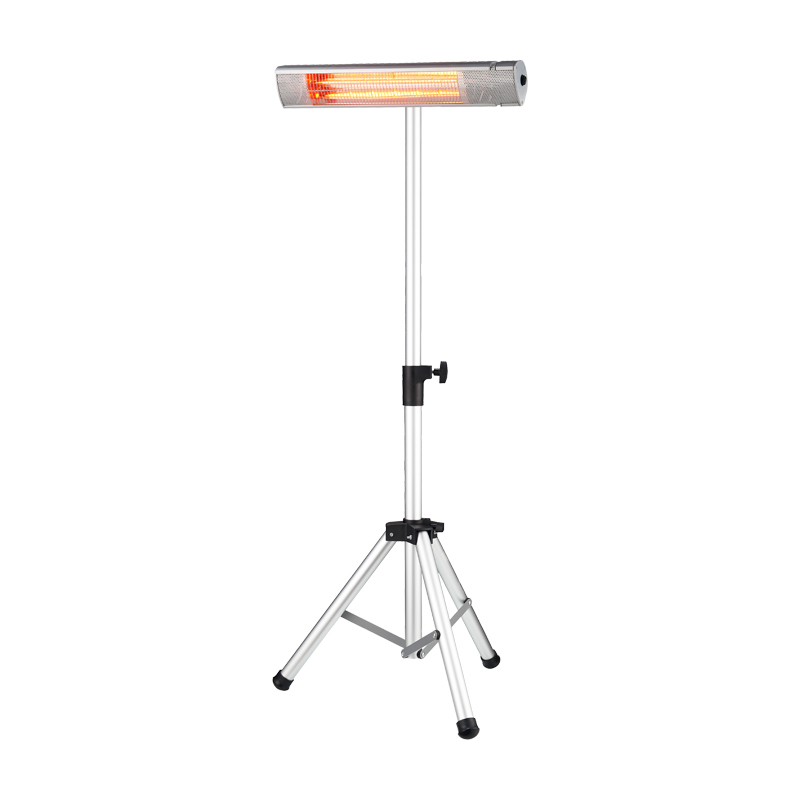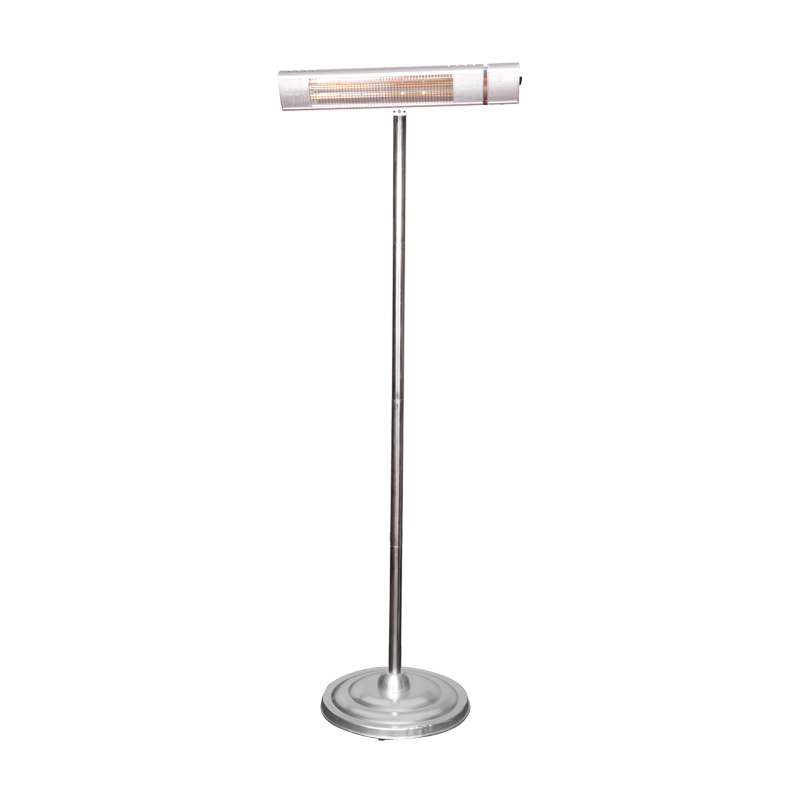Design and implementation of waterproof performance
When patio heaters are used outdoors, waterproof performance is one of the key factors to ensure the normal operation of the equipment. Manufacturers usually design heaters with a certain waterproof level according to different usage environments. Common waterproof levels include IPX4, IPX5 or even higher, which means that the equipment can still function normally under different degrees of water spray or rain conditions. Waterproof design is not only reflected in the sealing treatment of the shell, but also involves protective measures for button interfaces, power plugs and internal circuits. Reasonable use of sealing strips and waterproof materials can reduce the entry of moisture into the equipment, thereby preventing circuit short circuits or component damage. In addition, waterproof design also needs to take into account the heat dissipation of the equipment to avoid overheating problems caused by tight sealing. Through scientific design and material selection, patio heaters can be used safely in certain rain and humidity environments, extending their service life.
Windproof performance and its importance
Windproof performance directly affects the heating efficiency and safety of patio heaters. The outdoor environment is often accompanied by changes in wind force. Strong winds may cause damage to the flame or heating element of the heater, and even cause safety hazards. Therefore, manufacturers will consider the application of windshields or windshields when designing. These structures can effectively reduce the interference of wind on flames or heat sources. At the same time, windproof design can also help heat to be better concentrated and conducted, improving the heating effect. For electric heating patio heaters, windproof structures can reduce the wind chill effect and ensure stable temperature. Some models are also equipped with wind speed sensors, which can automatically adjust the power output according to wind force to cope with different wind conditions. In addition, the fixing method of the heater will also affect its windproof performance. A stable base or bracket can prevent the device from being blown down by the wind and ensure safe use.

The impact of material selection on protection performance
The waterproof and windproof performance of patio heaters depends largely on the materials used. Corrosion-resistant and rust-proof metal materials such as stainless steel and aluminum alloys are often used in the manufacture of housings and brackets to ensure that the equipment is not easily damaged even in humid environments. Plastic parts are mostly made of high-polymer materials with strong UV resistance and weather resistance to prevent aging and brittle cracking caused by sunlight and climate change. The density and surface treatment of the material will also affect the adhesion of water droplets and the impact of wind force. For example, a shell with a waterproof coating on the surface can reduce water stains and improve the overall protection effect. Appropriate material selection not only improves the durability of the equipment, but also reduces the maintenance frequency and cost to a certain extent.
Design standards and certification requirements
In order to ensure the waterproof and windproof performance of patio heaters in outdoor environments, relevant industry standards and certifications play an important role. Product design must comply with the protection requirements for outdoor electrical appliances in international safety standards such as IEC and UL. Through rigorous experimental tests, such as waterproof spray tests and wind pressure tolerance tests, manufacturers can verify whether the actual performance of the equipment meets the design indicators. These certifications are not only a symbol of product quality, but also provide users with a guarantee of safe use. Some markets have more stringent requirements for protection levels, especially in rainy or windy areas, where certification standards are an important consideration that cannot be ignored. The formulation and implementation of standards have promoted the continuous improvement of product protection performance.
The impact of the use environment on protection performance
The waterproof and windproof performance of patio heaters depends not only on the design of the product itself, but also on the actual use environment. The climatic conditions in different regions vary greatly, and extreme weather such as frequent rainfall, high humidity or strong winds will put forward higher protection requirements for heaters. In rainy areas, the heater should have a high waterproof level to prevent rain from penetrating into the internal circuit; in windy areas, the stability and windproof ability of the equipment should be considered more. When choosing and installing patio heaters, users should combine the local climate characteristics and arrange the equipment position reasonably to avoid exposure to direct strong winds or water accumulation. Appropriate shielding facilities such as awnings or windbreaks can also help improve the stability and life of the equipment.

The impact of maintenance and care on protective performance
Even patio heaters with good waterproof and windproof designs require regular maintenance and care to maintain their performance. The accumulation of dust, dirt and corrosion may affect the sealing and structural stability of the equipment, thereby reducing the protective effect. Users should regularly check the equipment housing, seals and connections according to the product instructions, clean surface stains and check for possible cracks or damage in a timely manner. In addition, the waterproof measures at the electrical connections must be kept intact to avoid malfunctions caused by poor contact. For parts that are susceptible to wind, such as wind shields and fixtures, their firmness must also be tested regularly. Through proper maintenance, the service life of the terrace heater can be extended to ensure that it continues to play its due protective role in the outdoor environment.
The impact of waterproof and windproof performance on user experience
The waterproof and windproof performance of the terrace heater is directly related to the user experience and sense of security. The equipment can still work normally in rainy or windy environments, so that users do not have to worry about sudden weather changes affecting the heating effect. At the same time, the stable windproof design reduces the risk of equipment lodging and improves safety during use. Good protective performance also reduces the cost of repair and replacement caused by equipment damage. When purchasing, users pay attention to the protection level and design details, and can choose products that are more suitable for their own use environment to obtain a more lasting and stable use experience. In addition, terrace heaters with perfect waterproof and windproof functions are more suitable for commercial places and outdoor activities to meet diverse needs.
Development trend of waterproof and windproof technology in the market
With the popularization of outdoor lifestyles, the waterproof and windproof technology of terrace heaters is also constantly improving. The application of new materials and new processes has made the equipment more possible in terms of protective performance. For example, the use of nano-coating technology can achieve a stronger waterproof effect on the surface while maintaining good air permeability. The combination of intelligent sensing technology and windproof design enables the heater to automatically adjust power according to the real-time environment, improving energy efficiency and safety. The modular design allows users to add or replace protective components according to environmental changes. In the future, with the integration and innovation of technology, the waterproof and windproof performance of patio heaters will be more accurate and diversified, meeting the needs of more complex and changing outdoor environments.
| Aspect | Description | Typical Standards/Values |
|---|---|---|
| Waterproof Rating | IPX4 to IPX5 common; protects against splashing and rain | IP Code (IEC standard) |
| Wind Protection Features | Wind shields, covers, and sensors to maintain heat output | Varies by model |
| Materials Used | Stainless steel, aluminum alloy, UV-resistant plastics | Corrosion resistance and durability |
| Safety Certifications | IEC, UL certifications for outdoor electrical devices | International safety standards |
| Maintenance Needs | Regular cleaning of seals, inspection of mounts and covers | User manual recommended intervals |
| Environmental Considerations | Suitable for humid, rainy, or windy climates | Regional climate adaptations |

 English
English 中文简体
中文简体 Français
Français Español
Español Language
Language 










